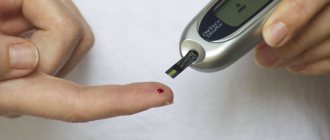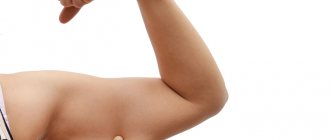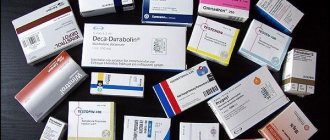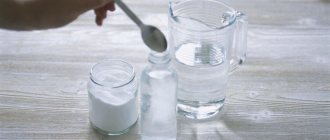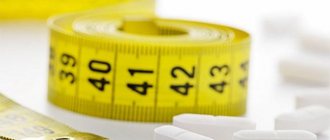Most of our compatriots, having felt discomfort or pain on the right side under the rib, begin to look for ways to help cleanse the liver at home. Especially such a search with further testing of all sorts of “folk remedies” on themselves is carried out by people who understand that they are not leading an entirely correct lifestyle, who are aware of their “love” for “junk food” and alcohol.
But our body is a smart self-renewing system. The processes of maintaining its own integrity and normal functioning of any cell occur every fraction of a second, without stopping either in sleep or on vacation. As long as the body copes and there are no symptoms of liver damage (we will talk about them later), it is not worth interfering with some folk remedies, even if they have been “tested” many times by the adviser himself. Such “efforts” can land you in a hospital bed and even - when using aggressive methods like celandine treatment - get a ticket to a consultation with a pathologist.
We are not saying that the liver does not need help: after all, this organ plays a colossal role in our life, and if it is damaged, a person is out of commission for a long time. But the best support for the main filter of our body is not the removal of ephemeral “toxins” at all, but the creation of optimal conditions for its work. How to cleanse the liver of toxins, what “pitfalls” you can break into and why – read on.
About the liver
This organ is one of the largest in the body. In terms of its structure, it is a gland, but it sends the products of its work not into the blood, like the endocrine endocrine gland, but into the gallbladder.
The liver performs the following functions:
- Protein synthesis. So, it produces: albumin - a protein necessary to retain the liquid part of the blood in the vessels;
- proteins that bind various hormones;
- proteins that bind toxins;
- globulins. Some of them work together with the immune system, destroying microorganisms, as well as remembering them for a faster response when they enter the body again;
- proteins of the blood coagulation system. Thus, the liver is involved in hemostasis: if this function is disrupted, spontaneous (without injury) massive bleeding can occur.
It captures the liver and other toxic substances, both those formed in the body (excess hormones, vitamins, substances that are normally produced during metabolism), and those that enter us through the mouth, skin, or with the air. Only rare substances, and those that enter the body by being absorbed in the vessels of the mucous membrane or mouth, or nose, can bypass the liver during their metabolism. The rest, no matter how they enter the body, necessarily pass through this organ.
It turns out that the liver is the largest filter in the body, which - and this is its uniqueness - is able to recover from only ¼ of the remaining healthy tissue. But it does not work like an industrial filter, whose cells can become clogged when filtered substances frequently pass through the “mesh”. At the cellular level, the structure of the liver is very complex, and does not resemble a sieve. Neutralization occurs through chemical reactions, as a result of which a potentially dangerous substance is modified into a non-hazardous one. There is another form of neutralization. It is carried out by special immune cells of the liver - reticuloendotheliocytes, which “absorb” and “digest” dangerous products contaminated with bacteria.
Therefore, it is necessary to cleanse the liver of alcohol or other substances not by some kind of “washing”, but by sufficient blood supply and the absence of potentially dangerous substances.
How to cleanse the liver with beet kvass and vegetable oil
You can also recommend a method on how to cleanse the liver of toxins using beet kvass. To do this, you need to take 3 fresh medium-sized beets. Wash thoroughly without peeling, cut into small cubes and place in a three-liter glass jar. Add 2 tablespoons of wheat flour and 0.5 kg of sugar there.
Before quickly cleansing the liver using this method, the jar with the infusion, closed with a plastic lid, should be stored for two days in a dark place at room temperature, stirring the contents twice a day. Then add 700g of raisins without seeds and stems, 0.5 cups of sugar, 4 cups of water and leave to ferment for 7 days, stirring once a day. On day 8, strain the contents of the jar. The result will be approximately 1 liter of beet kvass.
Then you need to start taking this kvass, 1 tablespoon 3 times a day, half an hour before meals, and do this until the kvass runs out. Take a break for 3 months, then repeat the course again, and after another 3 months - the third course. In a year, the liver will be completely cleansed and healthier.
How to quickly and effectively cleanse the liver using vegetable oil? There are two methods of such cleansing.
First way. For a week, every day in the morning on an empty stomach, drink half a teaspoon of high-quality vegetable oil, preferably olive oil. Over the next week, drink 1 teaspoon of oil, in the third week - 1 dessert spoon of oil, in the fourth week - 1 tablespoon of oil, in the fifth and final week you need to drink half a glass of vegetable oil in the morning on an empty stomach.
Second way. For 1-2 weeks, 2-3 times a day, rinse your mouth with vegetable oil (1 tablespoon), vigorously shaking it in your mouth, especially under the tongue. This should be done within 15-20 minutes. During this time, the oil will turn into a white mass, which has absorbed a wide variety of poisons and toxins that have entered through the outlets of the blood vessels and salivary glands located in the mouth. The resulting mass should not be swallowed under any circumstances. You need to spit it into the toilet and then rinse your mouth thoroughly. This method not only helps remove toxins from the liver, but also helps rid the body of toxins as a whole, and therefore significantly improves well-being.
Slags and toxins
There is a concept of “toxins” in medicine. This designates substances that are potentially dangerous to a particular organ or the body as a whole. Toxicologists call the waste products of microbes this way, but doctors of other specialties use a similar word to designate:
- household and industrial chemicals;
- poisons used to kill insects or weeds;
- medicines;
- some plants and mushrooms;
- substances that are formed in a diseased organ themselves (for example, with a malignant tumor) or those that it cannot neutralize, and they are forced to accumulate. In the case of liver diseases, these are products of protein decay, ammonia, specific neurotransmitters and bilirubin, which poison the brain.
Toxins accumulate in the body, many only in certain tissues. They are excreted in several ways (each has its own excretion path):
- through the lungs - with breathing (this route does not work if the liver is damaged);
- through the kidneys - with urine (if the liver is damaged and not temporarily “poisoned” by alcohol or “junk” food, this route is the main one until the liver tissue is restored);
- through the liver - with bile (in case of temporary “stunning” of the liver, when its structure is not damaged, this and the following detoxification paths will be the main ones);
- through the intestines - with feces;
- through the skin - with sweat.
The term “slag” is not used in medicine. This word is a popular analogue of “toxins”. Neither waste nor toxins accumulate in the liver. Only fats can be deposited here (this is called steatosis or fatty hepatosis) or copper (in Konovalov-Wilson disease). Toxins, passing through this organ, lead either to transient (temporary) disorders of the liver tissue or to permanent damage to its structure.
When a doctor says: “You need to cleanse the liver of toxins,” this is a figurative expression and means that through the joint efforts of the doctor and the patient, it is necessary to give the organ the opportunity to restore its tissue on its own (if there are no rare genetic lesions that will progress, then this is quite possible) .
Symptoms of liver damage
If its functioning is disrupted, the entire body suffers: the nervous system is affected, metabolism and hematopoiesis suffer, digestion is disrupted, the complexion and whites of the eyes change. Symptoms that the liver is suffering and require the help of a gastroenterologist or infectious disease specialist are as follows:
- yellow coloration of only the whites of the eyes or the skin too;
- the urine has darkened, which persists not only in the morning;
- light (clay-colored) feces;
- I want to sleep all the time;
- the slightest work tires;
- heaviness under the ribs on the right;
- loss of appetite;
- I feel sick just at the mention of fried or fatty foods.
Many symptoms are nonspecific, that is, they can appear in many diseases. Only a paramedic or a doctor (a person who has studied the structure and functions of all organs, as well as the symptoms of their damage for several years) can differentiate, that is, distinguish one from the other. And he should not only hear about the manifestations of the disease that bother you, but also examine you, palpate/percuss the liver, analyze its functions using blood, urine and stool tests, and learn from a functional diagnostics doctor the structural features of this organ according to ultrasound data.
If the doctor is convinced that these are signs of liver pathology, inpatient treatment in the appropriate hospital is recommended (independent treatment of liver diseases is deadly):
- if there has been poisoning with: drugs (tetracycline, salicylic acid, valproate, anti-AIDS or anti-malaria drugs, cordarone, methotrexate, arsenic, vitamin A), yellow phosphorus, mushrooms - treatment takes place in the toxicology department of a multidisciplinary hospital or gastroenterology department;
- if markers of viral hepatitis are detected, treatment is carried out in an infectious diseases hospital;
- if Doppler ultrasound reveals vascular pathology as a possible cause of liver damage, treatment is carried out in the vascular surgery department;
- when burns are possible causes of liver disease, therapy is carried out in the burn department;
- fibrosis, cirrhosis of the liver, Wilson-Konovalov disease, liver damage due to heat stroke or hypothermia are treated in the therapeutic department of a multidisciplinary hospital.
Time to sound the alarm
The liver rarely makes itself felt. However, thanks to some signs, you can understand that the organ needs cleansing:
- allergic reactions,
- headache,
- mucous discharge from the throat and nose,
- sleep disturbance,
- unpleasant odor from the mouth,
- nervousness,
- fast fatiguability,
- belching,
- disorders of the digestive tract,
- excessive gas formation, bloating,
- predisposition to constipation,
- a feeling of bitterness in the mouth.
https://youtu.be/zWXg9mVcGFI
Among the external manifestations that indicate slagging in the body, it is worth noting:
- acne,
- unhealthy skin color,
- formation of pigment spots.
With severe intoxication, the tongue may become coated and the whites may turn yellow. In addition, people report pain in the right hypochondrium, especially after eating unhealthy food.
The organ must be cleaned after a course of antibiotics or other drugs with an aggressive composition, or in case of abuse of alcoholic beverages and narcotic substances.
Perhaps the most important recommendation is to carry out cleansing manipulations before unpleasant symptoms appear. If several symptoms of intoxication are observed at once, then you should think about your health.
What methods can be used to treat the liver in a hospital?
- Detoxification infusion therapy or, popularly, “drip”. Here, 1.5-3 liters of crystalloid solutions (sodium chloride, Ringer's solution, 5% glucose solution) are poured into a vein, designed to quickly remove bilirubin and other products formed during liver damage with urine.
- Taking lactulose preparations (Duphalac), the task of which is to bind protein breakdown products and remove toxins from the intestine, which are formed by bacteria that have “raised their heads” in conditions of liver damage (before this, their growth was suppressed).
- Sorbents: Atoxyl, Activated carbon, Polysorb. Their task is to bind all toxic substances for the body from the intestines.
- Hepatoprotectors: “Heptral”, “Glutargin”, “Hepa-Merz”. Their task is to inactivate toxic products of nitrogen metabolism.
- Protein preparations that are administered intravenously: Albumin. It will bind toxic fat-soluble products, and, in particular, bilirubin, and then remove them. Albumin will also help retain water in the vascular bed.
- Single-group fresh frozen plasma transfusion. It contains all the coagulation factors that are so lacking in liver damage.
- Proteinase inhibitors: “Kontrikal”, “Gordox”. They are used to improve the condition of the blood coagulation system in conditions of its insufficiency.
- Plasmapheresis is a hardware method of purifying plasma from toxic products, when a certain amount of blood is removed from the vascular bed, it is centrifuged and only red blood cells are returned. Instead of your own plasma with a large amount of bilirubin, ammonia, and medium molecules, colloidal and crystalloid solutions, as well as a certain amount of single-group plasma, are transfused.
- Antiviral drugs based on interferon. They are used only for viral hepatitis and cirrhosis.
- Enema. This event is mandatory in case of liver damage, if there has been no independent stool in a day. Otherwise, a situation may occur that the products formed during food processing are absorbed.
The patient is prescribed a protein-free (in the acute stage) or low-protein diet. It is needed so that the body stops being poisoned by the products of rotting proteins, which a diseased liver is not able to neutralize.
What medications are suitable
In order to follow the step-by-step instructions, it is worth purchasing some medications for liver cleansing. All of them are available at any pharmacy:
- Allahol for cleansing the liver and the whole body is a drug that promotes the production and secretion of bile, increases its secretion;
- Magnesium sulfate – acts as a laxative and has a calming effect on the entire body;
- No-shpa - relieves spasm in smooth muscles;
- choleretic tea;
- Essentiale is a hepatoprotector that can be used in parallel with the removal of toxins to preserve the normal functioning of the liver.
READ ALSO: Delicious coffee at home: from choosing a variety to pouring it into a cup
You can take other medications to cleanse the liver from these groups. But in practice it has been proven that these are the ones that perform their function well in cleansing the liver.
Women's health: what drugs are used to treat cervical erosion?
How to make honey wrap at home in the next section.
Mechanical facial cleansing: https://clever-lady.ru/beauty/face/mehanicheskaya-chistka-litsa-v-domashnih-usloviyah.html.
What can you do at home?
Diet to help the liver
If there are no signs of liver damage, and you just want to help it better cope with stress such as alcohol and “harmful” fatty foods, you can do the following:
- Drink at least 2 liters of fluid per day (if there is no heart or kidney pathology). Drink the first 1-2 glasses on an empty stomach, cool.
- Stop drinking alcohol or reduce the amount.
- Reduce the volume, and then completely abandon fried and smoked foods, because they create an increased load on the liver tissue, which worsens its detoxification function. A similar rule applies to products with dyes, preservatives and stabilizers.
- Eliminate chocolate, game, sorrel, and green borscht from your diet.
- Eat more fresh fruits, vegetables and grains. Fiber-rich foods need to be ground.
- Meat and fish - only boiled or baked, low-fat varieties.
- Eggs - in the form of steam omelettes, but you can use 1 soft-boiled egg.
- Fermented milk products - everything, but low-fat and non-spicy. Ideally, homemade yoghurts, kefir, curdled milk or narine.
- Compotes, mousses and jellies are possible.
- Sweets include marmalade, honey, marshmallows, lollipops, and marshmallows.
- Preference should be given to baked, stewed and boiled dishes.
- Start your morning meal with a small amount of fat (for example, butter): to stimulate the contraction of the gallbladder and the release of bile.
- Try to give preference not to black tea, but to herbal teas with chamomile and mint. In this case, try to buy herbs at the pharmacy.
You can do the following breathing exercises:
- lie on the floor with your knees bent;
- take 10 breaths with your chest, controlling it with both hands, one of which lies on your stomach, the second on your chest (the first hand should not move);
- now you need 10 inhalations and exhalations with your stomach; control is the same;
- breathe a little at a normal rhythm until you rest;
- inhale through your chest, then roll the air, without exhaling, from the chest cavity to the abdominal cavity. Try to make about 10 such “rolls”, after which you can rest.
Dangerous cleaning methods
On the Internet and printed literature you can find many recommendations on how to cleanse the liver using folk remedies. Here it must be said that even if you decide to try some of them, first consult with your doctor about their advisability. We will present the most common and rather dangerous methods.
Frequent enemas
The method itself is not bad for eliminating constipation in the absence of organic intestinal pathology. But it must be performed with knowledge of technology, that is, with cold water. A large amount of warm liquid introduced into the rectum will certainly be absorbed, which is dangerous by increasing the load on the kidneys and heart and even developing cerebral edema (the latter is a deadly complication).
If enemas are performed frequently, in the absence of liver pathology, they can lead to dysbiosis, since water will wash out all the beneficial bacteria located there from the intestines (see enema for constipation). Another danger of an enema is injury to the rectal mucosa, which can lead (especially with hemorrhoids) to bleeding.
Urine therapy
Urine is what comes out after your own blood is filtered by your kidneys. That is, this is a product that the body initially “discarded” as waste.
Starvation
At the same time, the liver is not cleansed, but becomes tense: glycogen, a glucose depot, breaks down in it, protein synthesis is disrupted, which is why its own protein begins to break down. This leads to a change in blood pH, and this condition, if it exists for a long time, disrupts the functioning of the endocrine glands, and this, in turn, leads to anorexia.
dietary supplements
These are non-medicinal products that are “attributed” with the properties of helping the liver recover. But the actual composition of such additives is unknown, and the “help” is questionable. We would not recommend using such “drugs.”
Drinking large volumes of water
If the body is healthy, such short-term exposure may pass without a trace (but also without benefit). But if there is a deterioration in the functioning of the kidneys or heart, this can cause an exacerbation of their diseases, since they will have to cope with an increased volume of fluid.
Choleretic methods are also not safe
The following are methods that have a choleretic effect and are extremely dangerous for certain diseases and conditions of the body, namely:
- Gallstones (cholelithiasis), bile duct cancer, Vater's papilla of the gallbladder are conditions that cause obstructive jaundice
- Acute hepatitis
- Acute gastritis, stomach cancer, gastric ulcer and duodenal ulcer
- Liver dystrophy
- Pregnancy, threat of miscarriage
- Esophageal narrowing, esophageal cancer, esophageal varices
- Acute or exacerbation of chronic cholecystitis
- Bronchopulmonary pathologies accompanied by shortness of breath
- Hypertension in combination with the risk of stroke and other complications of vascular diseases.
None of these folk remedies should be used without consulting a doctor.
Tubage or “blind probing”
This is a technique when you drink a certain amount of choleretic (sorbitol, magnesia, oil, egg yolk) on an empty stomach or at night, after which you need to lie on your right side and put a heating pad or a bottle of warm water under it. The head end of the bed should be raised. You need to lie like this for at least half an hour. This method is dangerous:
- blocking the bile ducts with a displaced (as the outflow of bile will increase) stone;
- deterioration of the condition of the liver tissue, if it was already unhealthy;
- increased work of the pancreas, which is inextricably linked with the work of bile;
- exacerbation of the disease of the duodenum, into which an increased amount of bile enters, and with it the stomach.
Therefore, the previously popular tubes are now recognized as unsafe, ineffective, and are no longer used. They were replaced by drugs derivatives of ursodeoxycholic acid, which are prescribed only by a doctor according to strict indications (Ursofalk, Ursosan, Urosliv, Urodez, Urdoxa, see drugs for the treatment of the liver).
“Cleansing” with lemon juice and olive oil
Typically, these two drugs are used together to potentiate the choleretic effect. As a result, first the bile ducts, and then, under their action, the intestines begin to actively contract. From the gallbladder, bile with the protein fibrin (an indicator of stagnation) and small stones enters the duodenum. If there was a larger stone there, it will move, causing severe pain (biliary colic) and - if it cannot come out on its own - it will make it possible to get to the operating table.
Cleansing with oat decoction
Here it is proposed to soak the oat grains, and after a while, boil them and take them gradually. This product causes the release of large amounts of bile from the gallbladder. Emptying the bladder gives a signal to the liver to synthesize even more bile, which, under conditions of an already high load on it (cleansing is usually done for a reason, but after heavy libations or overeating), can now cause structural damage to the liver tissue.
This oatmeal decoction is contraindicated for kidney and heart diseases. It should not be taken by people suffering from grain intolerance, as this can lead to severe diarrhea and a deterioration in their general condition.
"Cleansing" with herbs
Traditional healers suggest “cleansing” the liver with one or more herbs, such as:
- corn silk;
- dandelion;
- immortelle;
- sagebrush;
- plantain;
- chicory;
- yarrow.
This intervention causes increased contraction of the gallbladder with the release of large amounts of bile into the duodenum. This causes a reflex from the pancreas, which should release enzymes. A lot of bile - a lot of enzymes - reactive pancreatitis (or exacerbation of chronic). And if there are stones in the gall bladder, then with the flow of bile they can move and block the bile ducts, which causes poisoning of the body with bile acids (cause severe itching) and bilirubin (damages the brain). This condition is treated surgically. In parallel, many herbs have a diuretic effect, which will not be useful for renal pathology.
Use of Medicines
Most often it is advised to choose Allohol. This is a drug that enhances the formation of bile. It consists of dried bile extract, garlic, nettle and activated carbon. It copes with its task perfectly in conditions accompanied by stagnation of bile in the ducts that remove it. But the drug is contraindicated for diseases of the liver itself: hepatitis, hepatic dystrophy, as it will force the already diseased organ to work in an increased mode (while it needs a gentle routine). You should not take pills even if there are stones in the gall bladder: a large volume of bile will definitely move the stone, and it will clog the thin tubes through which it should move.
Liver cleansing tea
The effect of this tea is to simultaneously enhance the production of bile by the liver and accelerate its excretion. As a result, the liver synthesizes a large amount of bile, which enters the intestine, which is unprepared for such a turn of events. The latter may become inflamed. Strengthening the work of the liver does not lead to its cleansing, but, on the contrary, to an increase in its problems, which could previously be compensated for. Thus, the secretory, hormone-synthesizing, and hemostatic functions of the liver may suffer.
Beet
Beetroot, or rather its decoction, is a powerful choleretic agent that increases the synthesis of bile by the liver. Its use leads to the previously described effects: stone displacement, liver tissue dysfunction, reactive pancreatitis, gastroduodenitis, exacerbation of peptic ulcer disease.
Rose hip
A decoction of rose hips has a choleretic effect. What this leads to can be read in the example of tubes, tea for cleansing the liver, or taking oil.
What is tubage
Tubage is a procedure for gently cleaning the liver and bile ducts from stagnant fluid. It is carried out in order to activate the contractility of organs. You can learn how to cleanse the liver at home without specialized education. The effectiveness of the therapy method is due to the thermal effect on the organ using a heating pad. Before the procedure, a solution is taken orally to help flush out bile from the pancreas and liver along with waste, parasites and toxins.
Sounded
The traditional probe method of liver cleansing is carried out in a hospital. The procedure is done in the first half of the day, on an empty stomach. The patient sits on a chair with a backrest, a towel is placed on the chest area, and a saliva collection tray is placed in his hands.
The sterile probe is thoroughly treated with an antiseptic solution, after which the patient should swallow it. When the probe reaches the desired level, a solution of magnesium sulfate at a temperature of around 40 °C is injected into the body. It promotes the movement of bile from the duodenum to other organs.
Blind
Cleaning the liver at home is carried out using the blind tubage method. This method is considered more gentle, since it leads to the elimination of bile naturally, during bowel movements. The recipe for the procedure is selected individually, taking into account the current state of the internal organs. Anyone who suffers from slagging should know how to cleanse the liver using a blind dubage. The result of treatment is neutralization of the body from toxins and cleansing of the ducts of the lymph nodes.

